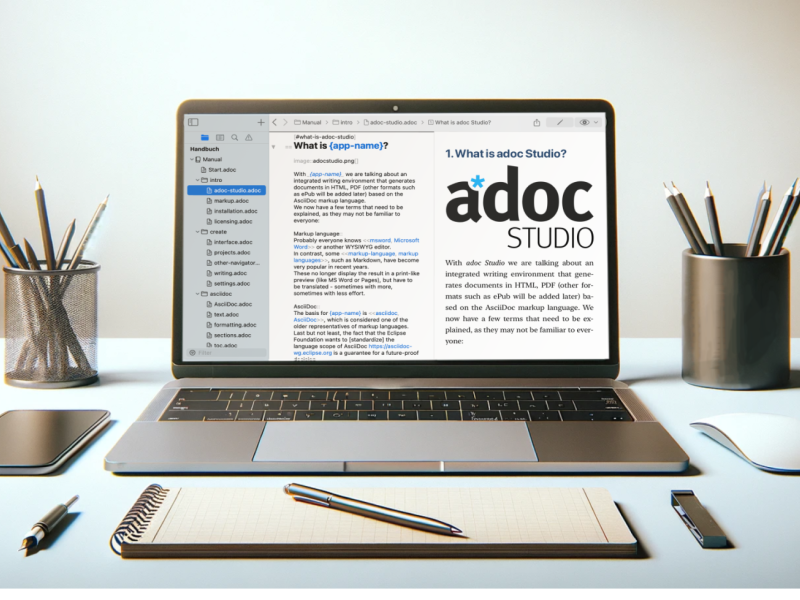Posted in technical writing.
How to Improve Your Writing Style for Clarity and Readability
Antoni Cherif – .
Writing requires practice. The difference between good and bad style often lies in the details. Here are simple tips for immediate improvement.
Why should I improve my writing style?
When writing, we often tend to directly transfer our thought patterns and natural way of speaking onto paper. This is partly due to modern communication via emails, text messages, and blogs. But who are we writing for and on what topic?
Every text has a specific purpose. Whether it's a business letter, a love letter, or a technical document, the main task of a text is to convey the information and message as clearly and understandably as possible. The sender-receiver principle plays a crucial role in this. Therefore, the writing style becomes one of the author's most important tools.
It is important to present correct spelling, grammar, and content clearly for the readers. Stylistic errors prevent the reader from perceiving the author's intended message. In the worst case scenario, a poor writing style can lead to the reading being abandoned.
Therefore, the writing style is of immense importance for every author, whether in a novel, a non-fiction book, or a technical manual.
There are several reasons why it makes sense to improve your writing style:
Clearer communication: A good writing style helps to convey thoughts and ideas more clearly and precisely, thereby avoiding misunderstandings and making communication more effective.
Persuasive argumentation: A persuasive writing style can help ensure that your arguments and viewpoints are better understood and accepted. This can enable you to persuade and influence others more effectively.
Professional appearance: A polished writing style appears professional and competent. Particularly in professional contexts, this can leave a positive impression on supervisors, colleagues, or clients.
Improved readability: A good writing style makes texts more pleasant to read. A reader will continue reading until the end if the text is clearly structured and formulated in an engaging manner.
Personal development: By consciously working on your writing style, you can further develop your language skills and improve as an author. This can have a positive impact on various areas of life, including personal and professional development.
What constitutes good writing style?
This question is complex and cannot be thoroughly addressed here. However, there are some simple and effective measures to quickly improve writing style and effectively optimize existing texts. It is important to pay attention to grammar and spelling and to reduce the length of the texts.
Less is often more. This principle applies not only in the field of architecture and design but also in writing. Form follows function is a basic rule that can be applied well. Here, the function of the text is paramount, while the form follows this purpose. This means that content takes absolute precedence, followed by prose.
Effective tips for a good writing style
Sentence Rhythm:
When writing, avoid overly complex sentences. Instead, break statements into multiple sentences.
Having too many short sentences in a row can make the text sound monotonous. On the other hand, several long sentences in succession can be difficult to read and understand.
A good text is characterized by a balance between short and long sentences.
Filler Words:
Filler words are really quite unnecessary and they make sentences unnecessarily long without actually providing much meaningful content.
Filler words make sentences unnecessarily long and offer little content.
Example: "Filler words are really, like, totally unnecessary and they sort of make sentences, like, kind of completely long without actually offering much meaningful content,sort of, you know." In short: "Filler words are unnecessary!"
Modal Verbs:
Avoid modal verbs (can, must, may...). They are often unnecessary.
Example: "The topic of writing style interests me in order to be able to write better" replace with: "... to write better."
Constructions with modal verbs are not only unnecessary, they also convey uncertainty.
Passive Voice:
Avoid the passive voice, as it is typical of bureaucratic language.
Example: "Access to the construction site is not allowed" much better: "Please do not enter the construction site."
The passive voice can come across as the author trying to assert their authority.
Nominal Style:
Avoid the nominal style, which consists of nominalized verbs.
Example: Typical of the often artificially created nouns are "preparation," "objective setting," "implementation," or "feasibility."
The nominal style results in sentences like: "Failure to adhere to the writing style will be punished with refusal to read!". Are there people who enjoy reading such sentences? It's better to say: "Readers refuse texts that do not exhibit an appropriate writing style."
Language Tone:
Avoid colloquial language; it has nothing to do with writing and uses completely different stylistic devices. Even the grammar, sentence structure, and vocabulary are generally not compatible with the written word.
Example: "It must have been around 2010 or 2011,[...]" less colloquial: "Approximately around 2010 or 2011,[...]"
Active Verbs:
Use active verbs, as they are the most important word group. Avoid static verbs like "to be located," "to contain," "to exist," or "to be present." Active verbs make your texts dynamic and lively.
Example: Instead of writing "The button is located in the toolbar," try "You can find the button in the toolbar." Using active verbs makes the sentence more dynamic and lively. Additionally, by using direct address, you make the sentence more personal.
 adoc Studio
adoc Studio
Organize, Write and Share.
Documentation in AsciiDoc.
Organize, Write and Share.
Summary
After you have established a red thread for the content of your text, you should try to write it in portions. Imagine building blocks that you work through in the predetermined order. Focus only on the statement of each text block. The mistake often lies in mentally lingering on the next paragraph. This harms text comprehension.
Content Check:
Read the paragraph after you have written it. Can you understand the content yourself, or have you not managed to convey the information in text form as desired?
Rewrite the non-informative sentences.
Style Check:
Check the length of the sentences. Avoid nested, long, or punctuation-filled sentences. Avoid colons, dashes, and semicolons wherever possible.
Change the sentence length and rhythm.
Be brief and try not to be long-winded. Brevity is the soul of wit.
Write actively and with verbs.
Do not write as you speak. Colloquial language is for speaking.
Avoid modal verbs and nominal style.
Avoid proverbs, alliterations, and other rhetorical embellishments.
Layout Check:
Use paragraphs. Summarize text blocks thematically.
Divide the content for better readability.
Prefer words with fewer syllables.
Filler words make your text unnecessarily long. Cut out anything that is not necessary.
Do not use emojis.
Proofreading
Once you're satisfied with your text, you should proofread it. In most publishing houses, this process is automated. If not, you can seek someone experienced in editing texts. Alternatively, utilize an AI tool such as Gemini or ChatGPT, which are designed to understand and refine texts effectively.
This way, you can receive nearly flawless proofreading for free. Simply issue the command "Proofread, correct, keep it concise, and use an active voice:" followed by your own text. Don't use the AI to compose your texts, but rather to proofread them.
Good luck with your writing!
You might also like
-
What is Technical Writing?
- Marvin Blome
- Published on
-
How to get into Tech Writing?
- Antoni Cherif
- Published on
-
Markup versus WYSIWYG
- Marvin Blome
- Published on




